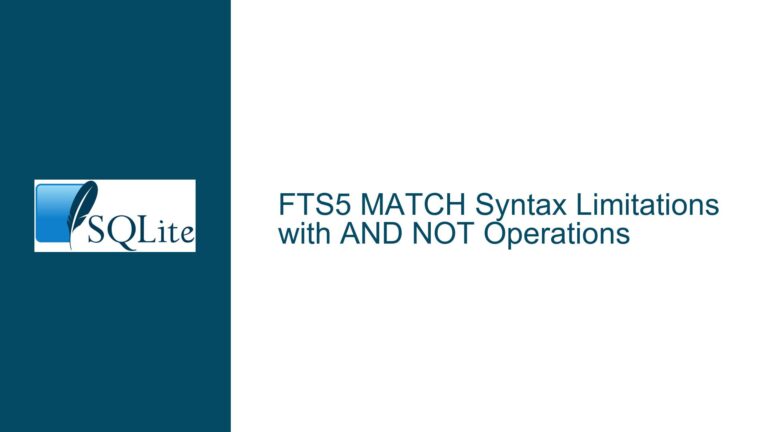Breadth-First Search in SQLite: Handling Loops and Stopping Conditions
Breadth-First Search Implementation Challenges in SQLite
Breadth-first search (BFS) is a fundamental algorithm used to traverse or search tree or graph data structures. It starts at a given node (often called the "root" or "origin") and explores all its neighbors at the present depth level before moving on to nodes at the next depth level. While BFS is straightforward to implement in procedural languages like Perl or Python, translating it into SQL, particularly in SQLite, presents unique challenges. SQL is inherently declarative, meaning it focuses on what to retrieve rather than how to retrieve it. This mismatch between procedural algorithms and declarative queries often leads to confusion and inefficiencies when implementing BFS in SQLite.
The primary challenge in implementing BFS in SQLite lies in handling loops in the graph and ensuring the query stops once the desired destination is reached. In procedural languages, loops are managed using data structures like queues and visited node lists, but SQL lacks these constructs. Instead, SQLite relies on recursive Common Table Expressions (CTEs) to simulate iterative processes. However, recursive CTEs can lead to infinite loops if not carefully managed, especially when the graph contains cycles. Additionally, stopping the recursion early when the destination is found is non-trivial in SQLite, as recursive CTEs are designed to exhaustively explore all possible paths.
Infinite Loops Due to Cyclic Graphs and Lack of Early Termination
One of the most significant issues when implementing BFS in SQLite is the presence of cyclic graphs. In a cyclic graph, nodes can be revisited indefinitely, causing the recursive CTE to run endlessly. For example, consider a graph where node 1 is connected to node 2, and node 2 is connected back to node 1. A naive recursive CTE would repeatedly traverse the path 1 → 2 → 1 → 2 → ..., never terminating. This behavior is exacerbated when the graph contains multiple interconnected cycles, making it difficult to ensure the query completes in a reasonable time.
Another critical issue is the inability to stop the recursion early once the destination node is found. In procedural implementations, the algorithm can immediately return the result upon finding the destination. However, SQLite’s recursive CTEs do not support early termination. Instead, they continue to explore all possible paths, even after the destination has been reached. This inefficiency can lead to unnecessary computation and significantly longer query execution times, especially in large graphs.
The combination of cyclic graphs and the lack of early termination mechanisms makes implementing BFS in SQLite particularly challenging. Without proper safeguards, the query may either run indefinitely or produce an overwhelming number of redundant results, making it impractical for real-world use.
Managing Loops with Path Tracking and Limiting Recursion Depth
To address the challenges of cyclic graphs and early termination, two key strategies can be employed: path tracking and limiting recursion depth. Path tracking involves maintaining a record of visited nodes to prevent revisiting them, effectively breaking cycles. Limiting recursion depth ensures the query does not explore paths beyond a certain length, which can help prevent infinite loops and reduce unnecessary computation.
Path Tracking with String-Based Path Representation
One effective way to implement path tracking in SQLite is by using a string-based representation of the path. Each recursive step appends the current node to the path string, and a check is performed to ensure the node has not been visited before. This approach leverages SQLite’s INSTR function to detect whether a node already exists in the path string. For example, if the path string is /1/2/3/, and the current node is 2, the INSTR function can determine that 2 is already in the path, preventing the query from revisiting it.
Here’s an example of how this can be implemented:
WITH RECURSIVE paths (origin, jumps, destination, path) AS (
VALUES (1, 0, 1, '/1/') -- Start with the origin node
UNION
SELECT paths.origin, (jumps + 1), pc.child, path || pc.child || '/'
FROM pc, paths
WHERE pc.parent = paths.destination
AND INSTR(path, '/' || pc.child || '/') = 0 -- Prevent revisiting nodes
)
SELECT * FROM paths WHERE jumps > 0;
In this query, the path column stores the sequence of visited nodes as a string. The INSTR function checks whether the current node (pc.child) is already in the path. If it is, the node is skipped, effectively breaking cycles.
Limiting Recursion Depth
Another strategy to prevent infinite loops is to limit the recursion depth. This can be achieved by adding a LIMIT clause to the recursive CTE, restricting the number of recursive steps. For example, setting a limit of 100 ensures the query explores paths up to 100 hops long. While this approach does not guarantee finding the shortest path, it provides a practical way to control query execution time and prevent infinite recursion.
Here’s an example of limiting recursion depth:
WITH RECURSIVE paths (origin, jumps, destination) AS (
VALUES (1, 0, 1)
UNION
SELECT paths.origin, (jumps + 1), pc.child
FROM pc, paths
WHERE pc.parent = paths.destination
LIMIT 100 -- Limit recursion depth
)
SELECT * FROM paths;
By combining path tracking and recursion depth limiting, you can effectively manage cyclic graphs and prevent infinite loops in SQLite. These techniques ensure the query terminates in a reasonable time and produces meaningful results.
Optimizing BFS Queries for Performance and Scalability
While the above strategies address the core challenges of implementing BFS in SQLite, further optimizations can improve query performance and scalability. These optimizations include minimizing redundant computations, leveraging indexing, and structuring the graph data for efficient traversal.
Minimizing Redundant Computations
One common issue with recursive CTEs is the generation of redundant paths. For example, in a graph with bidirectional edges (e.g., 1 → 2 and 2 → 1), the query may explore the same path multiple times from different directions. To minimize redundant computations, you can enforce a rule that prevents revisiting nodes or traversing edges in both directions. This can be achieved by maintaining a list of visited nodes or using a unique constraint on the path.
Leveraging Indexing
Proper indexing is crucial for optimizing BFS queries in SQLite. Indexes on the parent and child columns of the graph table (pc in the examples) can significantly speed up the recursive joins. Without indexes, each recursive step would require a full table scan, leading to poor performance, especially in large graphs.
Here’s an example of creating indexes for the pc table:
CREATE INDEX idx_pc_parent ON pc(parent);
CREATE INDEX idx_pc_child ON pc(child);
These indexes ensure that the recursive joins in the CTE are performed efficiently, reducing query execution time.
Structuring Graph Data for Efficient Traversal
The way graph data is structured can also impact query performance. For example, storing bidirectional edges explicitly (e.g., 1 → 2 and 2 → 1) can simplify the query logic but may increase storage requirements. Alternatively, you can store only one direction and handle bidirectional traversal in the query. Choosing the right structure depends on the specific use case and the nature of the graph.
Example: Full BFS Implementation with Optimizations
Combining all the techniques discussed, here’s a complete example of a BFS implementation in SQLite:
-- Create the graph table with indexes
CREATE TABLE pc (
parent INTEGER NOT NULL,
child INTEGER NOT NULL,
PRIMARY KEY (parent, child),
UNIQUE (child, parent)
) WITHOUT ROWID;
CREATE INDEX idx_pc_parent ON pc(parent);
CREATE INDEX idx_pc_child ON pc(child);
-- Insert sample data
INSERT INTO pc VALUES
(1, 2), (1, 3), (2, 1), (2, 5201), (5, 2),
(2, 5), (5201, 2), (3, 1), (3, 15), (15, 3),
(15, 4), (4, 5), (4, 15), (5, 4);
-- BFS query with path tracking and recursion depth limit
WITH RECURSIVE paths (origin, jumps, destination, path) AS (
VALUES (1, 0, 1, '/1/') -- Start with the origin node
UNION
SELECT paths.origin, (jumps + 1), pc.child, path || pc.child || '/'
FROM pc, paths
WHERE pc.parent = paths.destination
AND INSTR(path, '/' || pc.child || '/') = 0 -- Prevent revisiting nodes
LIMIT 100 -- Limit recursion depth
)
SELECT * FROM paths WHERE jumps > 0;
This query efficiently performs a BFS on the graph, avoiding infinite loops and minimizing redundant computations. By leveraging path tracking, recursion depth limiting, and proper indexing, it ensures optimal performance and scalability.
Conclusion
Implementing breadth-first search in SQLite requires careful consideration of the challenges posed by cyclic graphs and the lack of early termination mechanisms in recursive CTEs. By employing strategies such as path tracking, recursion depth limiting, and query optimization, you can overcome these challenges and build efficient BFS queries. These techniques not only ensure the query terminates in a reasonable time but also improve performance and scalability, making SQLite a viable option for graph traversal tasks.






